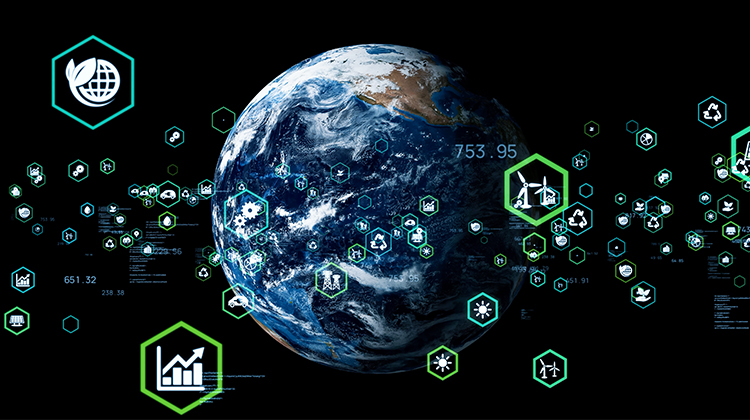May 2023
Turning Any Surface into Solar Energy in Pursuit of Carbon Neutrality
March 2023

Heliatek Headquarter |©Heliatek
When Guido van Tartwijk looks at buildings, he thinks of energy. Not the energy that buildings burn through, which is substantial, but the energy that they could be generating. Office towers, apartment blocks, warehouses, greenhouses––just about any structure of any size or shape could be outfitted with thin, lightweight, bendable panels that convert sunlight into electricity. Rather than drawing electricity from the grid, buildings could be adding to it.
Van Tartwijk is the CEO of Heliatek, a company in Dresden, Germany, that specializes in ultrathin-film organic solar cells. In theory, Heliatek’s cells are flexible enough to use on any building exterior––flat, curved, domed, twisted––easily attached with adhesives and weigh a fraction of the 20 kg per square meter of conventional panels.
“We have a technology that can produce electricity on basically every surface that you can think of. Japan has many people and buildings. It gets a lot of sunshine, too. On the other hand, space for installing solar panels is becoming scarce. I saw a clear need for our products,” said van Tartwijk. With its announcement in August, 2022, of a tie-up with Japanese energy provider Looop, Heliatek is expanding its rollout of ultrathin-film solar panels in Japan. And not a moment too soon.
Japan, the world’s third-largest economy and fifth-largest carbon emitter, has pledged to become carbon neutral by 2050. In its green growth strategy![]() , the Government of Japan plots out how the country will wean itself off of fossil fuels and coal-burning thermal power to reach net-zero emissions. The plan covers a lot of ground: wind farms, geothermal plants, railways that only use renewable energy, airplanes that run on biofuel, hydrogen refueling stations for cars and cargo ships, home-use batteries for excess power, depots that store carbon sucked from the atmosphere.
, the Government of Japan plots out how the country will wean itself off of fossil fuels and coal-burning thermal power to reach net-zero emissions. The plan covers a lot of ground: wind farms, geothermal plants, railways that only use renewable energy, airplanes that run on biofuel, hydrogen refueling stations for cars and cargo ships, home-use batteries for excess power, depots that store carbon sucked from the atmosphere.
In this mix of the proven and yet-to-be-proven, renewable energy is expected to contribute a sizable share. By 2030, Japan is aiming for renewable energy to account for 36 to 38 per cent of its electricity supply. (The Asia-Pacific region is now the largest and fastest growing segment![]() of the global renewable energy market, with a nearly 30 per cent share.)
of the global renewable energy market, with a nearly 30 per cent share.)
Laboratory for Energy Experiments
With its lofty targets and steady energy demand, Japan is becoming a testing ground for global companies’ best new ideas. In August, 2022, US aircraft manufacturer Boeing announced the opening of its Boeing Research & Technology center in Nagoya, central Japan, in a tie-up with Japan’s Ministry of Economy, Trade and Industry (METI). The company will explore what it calls “zero climate impact aviation”––sustainable fuels, hybrid-electric propulsion, hydrogen propulsion, batteries, robotics and composite materials manufacturing. In 2021, Germany’s Siemens Energy revealed plans to join up with Japan’s materials specialist Toray to develop non-polluting hydrogen production technologies, a project that’s tapped into the Government of Japan’s 2 trillion yen (US14.8 billion dollars*) Green Innovation Fund.
-
*
Converted at 130 yen to the US dollar
Japan’s Promising Solar Market
Japan’s near-term prospects for solar energy seem especially promising. In the global photovoltaics market, Japan ranks fourth in installed capacity** and its growth streak is expected to continue. Between 2023 and 2028, the Japanese market is forecast to expand at a compound annual growth rate of 9.2 per cent***. The government has set a target for solar energy to supply up to 16 per cent of Japan’s electricity by 2030.
-
**
After China, EU and US. Source: “Snapshot of Global PV Markets 2022,” IEA Photovoltaic Power Systems Programme.
-
***
Forecasts by Mordor Intelligence
Unlike in recent years, mega-sized solar projects aren’t expected to be a driving force. Already, much of mountainous Japan’s flat areas have been filled with sprawling solar farms. So where would the country put more solar panels? Empty (or partly empty) rooftops––which there’s still plenty of. In mid-2021, the Government of Japan unveiled plans to add solar panels to schools, public venues and government buildings over the next two decades. The Tokyo Metropolitan Government has announced its own mandate for homes built in the capital to be equipped with solar energy from fiscal 2025. Japan's Environment Ministry has predicted that all of the additional solar panels could generate up to 18.6GW) of energy, equivalent to 28 percent of the country’s current solar energy output.

R&D |©Heliatek
Next-Generation Solar Hopes
There are growing expectations for commercializing new super-thin![]() (564KB) , lightweight, flexible solar cells in Japan to achieve its carbon-neutral goals. Globally, the thin-film photovoltaics market is forecast to grow
(564KB) , lightweight, flexible solar cells in Japan to achieve its carbon-neutral goals. Globally, the thin-film photovoltaics market is forecast to grow![]() at a CAGR of 10% over the next decade to US6.1 billion dollars.
at a CAGR of 10% over the next decade to US6.1 billion dollars.
These days, Japanese manufacturers––including Toshiba, Panasonic, Kaneka, Sekisui Chemical and Enecoat Technologies––are racing to develop so-called perovskite cells. These new photovoltaics using halide perovskites are thinner and involve fewer production process steps than conventional silicon panels, but they have shorter lifespans and are difficult to mass-produce. Sekisui Chemical![]() and West Japan Railways have said they will begin a trial using perovskite solar cells at a station in Osaka from 2025, while KDDI
and West Japan Railways have said they will begin a trial using perovskite solar cells at a station in Osaka from 2025, while KDDI![]() and Enecoat are starting experiments for industrial-scale production of perovskite cells eying the introduction to KDDI’s mobile base stations.
and Enecoat are starting experiments for industrial-scale production of perovskite cells eying the introduction to KDDI’s mobile base stations.
Heliatek says its organic solar cells aren’t yet suitable for homes or apartment blocks. That’s because they’re less efficient at generating electricity than conventional photovoltaic panels. But they can be installed where conventional solar cells can’t––the facade of a building, the stem of a wind turbine, atop a tarp covering at a sports arena, or in places where it’s extremely hot. For Japan to achieve carbon neutrality, it will likely need conventional silicon panels as well as new ultrathin-film cells, said Looop’s CEO Soichiro Nakamura. “The introduction of ultra-thin film solar cells will accelerate the achievement of this goal,” he said.

Left:Rooftop Installation in Japan; Right:Bus Stop Test Site at Ristumeikan University |©Looop Inc
Pent-up Demand for Green Tech
For Heliatek––which has completed some 30 pilot projects in Europe, the Middle East and Asia––the chance to extend its reach into Japan was too good to pass up. The German company picked Looop as its partner after winning a startup competition in London, called the Japan Energy Challenge, and meeting with several suitors. “Looop is fast-moving, they are embracing innovation, and they understand what is necessary to get our product into the market,” said van Tartwijk.
Looop’s network in Japan and familiarity with the local energy market and regulations will likely remove many of the hurdles that Heliatek would have faced on its own. So far, the two companies have run a pilot test on Heliatek’s solar cells at Ritsumeikan University’s campus in Shiga Prefecture. In the months since their partnership announcement, the two companies have been inundated with requests for their lightweight OPV films in Japan, evidence of strong interest in such a versatile solution. The interest did not come as a total surprise to Heliatek as this is also happening on a global level. But it was also revealing: a glimpse of Japan’s pent-up demand for new green tech ideas that awaits new entrants.

Van Tartwijk, CEO of Heliatek |©Heliatek
Learn More
Contact Us
Investing in and collaborating with Japan
We will do our very best to support your business expansion into and within Japan as well as business collaboration with Japanese companies. Please feel free to contact us via the form below for any inquiries.
Inquiry FormJETRO Worldwide
Our network covers over 50 countries worldwide. You can contact us at one of our local offices near you for consultation.
Worldwide Offices

































